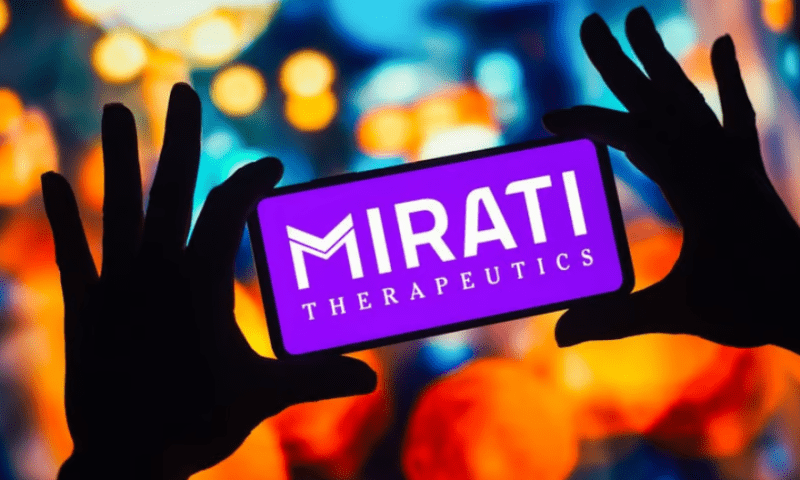In a potential key battleground for KRAS inhibitors that involves combination with Merck’s PD-1 king Keytruda, Mirati Therapeutics’ adagrasib appears to be pulling ahead of Amgen’s first-to-market Lumakras in the latest clinical data revelation. And Mirati’s CEO wasn’t shy about his optimism.
Adagrasib, given in tandem with Keytruda, shrank tumors in 49% of 53 patients with newly diagnosed KRAS G12C-mutated non-small cell lung cancer (NSCLC) in a phase 2 trial, according to data to be presented at the ESMO Immuno-Oncology Congress 2022. The combo also showed relatively low liver toxicity, relieving a major safety concern.
With the new Keytruda combination results from the KYRSTAL-7 trial and other clinical data, “I think we’re the KRAS leader, and we will set the direction where this KRAS agent goes,” CEO David Meek said in an interview with Fierce Biotech ahead of the data release.
Based on the phase 2 results, Mirati is moving the adagrasib-Keytruda regimen into phase 3 testing in front-line NSCLC soon. The company met with the FDA in September, and the agency has agreed with the trial design, Meek said. Mirati will initially target patients with low PD-L1 expression for a phase 3, he said.
“We believe a trial evaluating adagrasib + [Keytruda] in the TPS <50% represents a reasonable initial path forward in an area of unmet need,” Meek told Fierce Biotech in a statement.
Mirati’s stock tanked 18% to around $77 in premarket trading Tuesday, compared to a prior close of $92.75.
But during an investor call Wednesday, Mirati said it’s planning a second phase 3 for the PD-L1-high population with TPS score of at least 50%. The trial will pit the adagrasib-Keytruda combo against Keytruda alone.
The adagrasib-Keytruda pairing delivered the 49% overall response rate after investigators followed 53 patients for a median 3.5 months. Among patients with high PD-L1 expression at total proportion score of 50% or above, responses were observed in 59% of patients. In those with PD-L1 between 1% and 49%, the response rate was 48%. Three of ten (30%) individuals with PD-L1-negative tumors also responded.
Keytruda monotherapy is FDA-approved for newly diagnosed PD-L1-high NSCLC, and it has limited power against untreated PD-L1-negative NSCLC. So whether adagrasib needs the PD-1 agent in the PD-L1-negative subgroup remains in question.
In PD-L1-negative disease, Mirati considers monotherapy adagasib as a “pathway” that it’s studying, Meek said. During Wednesday’s investor presentation, Mirati noted PD-L1-negative represents a potential opporunity for an accelerated approval development path for adagrasib monotherapy.
But the company will also study the PD-1 combination in this population, because Keytruda plus chemotherapy can treat all patients regardless of PD-L1 status, and Mirati’s goal is to replace chemo alongside Keytruda, he said.
The tumor response rate came slightly below an earlier analysis Mirati shared in June at the American Society of Clinical Oncology annual meeting, which counted fewer patients. But it came in line with the 48% threshold that JPMorgan analysts led by Eric Joseph in September said would bode well for phase 3 development, or the 50% that SVB Securities analysts previously said Mirati investors were counting on.
Meek also suggested the number may improve as patients are treated longer, pointing to experience from adagrasib’s monotherapy trial. Among 25 patients who were enrolled in KRYSTAL-7 for at least six months, the tumor response rate was 56%.
While adagrasib is expected to secure an FDA approval as a monotherapy in previously treated NSCLC soon, combination with Keytruda in front-line patients represents a larger market. In their September note, JPM analysts put the total addressable market for KRAS inhibitors in that first-line setting at $1.5 billion for the U.S. and EU.
The JPM team borrowed the 48% overall response benchmark from Keytruda’s chemo combo performance in the phase 3 KEYNOTE-189 trial, which included patients with KRAS G12C mutations.
Meek also agreed with KEYNOTE-189 being the current standard of care in the front-line NSCLC setting, and that replacing chemo alongside Keytruda for KRAS G12C-mutant patients is “where the big opportunity is.”
Another key question heading into the KRYSTAL-7 update was safety, or liver toxicity to be specific. Amgen in August reported Lumakras’ Keytruda combination data from the CodeBreaK 100/101 trials, which included both treatment-naïve and checkpoint inhibitor-experienced NSCLC patients. It flagged an alarming signal with grade 3 or 4 liver toxicity hitting as high as 50% as shown in increased liver enzyme levels. The problem left analysts questioning the very combinability of Lumakras and Keytruda and forced Amgen to ditch concurrent dosing to instead explore a Lumakras lead-in regimen.
In Mirati’s earlier data release for KRYSTAL-7, grade 3 or 4 ALT and AST elevations were both below 5% among 37 patients after about two months of follow-up. But industry watchers wanted to see more patients and longer follow-up to be sure.
Now, the latest data showed grade 3 ALT and AST increases at 8% and 9%, respectively, among 75 patients after 3.5 months of median follow-up. No grade 4 or death was reported. In their September note, the JPM team described grade 3/4 liver-related side effect rates “in the low teens or below” as a clean tolerability profile.
Still, 3.5 months is a rather short period of time, especially when compared with 12.8 months of median follow-up in Amgen’s analysis. But Meek said Amgen doesn’t expect the liver side effects to build over time. That’s because the median time to the onset for ALT and AST abnormalities was 26 days and 37 days, respectively, in KRYSTAL-7. And only one patient experience new treatment-related ALT/AST problem after three months.
Mirati’s latest readout, though still limited in patient size and follow-up time, will for sure put Amgen on notice. Adagrasib and Lumakras are slated to duke it out in previously treated NSCLC, and the battle is now spreading to front-line development.

